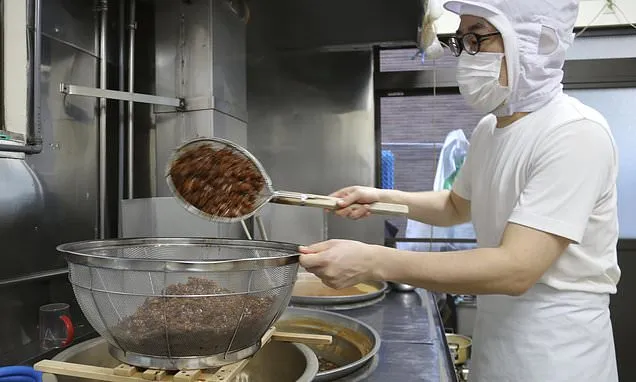TOKYO (AP) - Their morning starts at 5 a.m.
The father and son don´t speak to each other. They don´t need to. They barely look at each other as they go briskly, almost mechanically, from task to task. Beads of sweat glisten on their foreheads.
It´s the same work they´ve been doing at their shop for years: Cooking in big metal pots the ancient Japanese food tsukudani.
It's preserved food invented long before the advent of modern refrigeration, dating back to the samurai Edo Era more than 200 years ago.
Pieces of tuna, tiny shrimp, seaweed and other ingredients get simmered in a sweet syrup of soy sauce, sake and sugar. The air in the shop becomes damp, pungent, sweet.
Today, it´s clam tsukudani: Two pots from 6 a.m. to 7 a.m., and two more from 7 a.m. to 8 a.m. They´ll cook other items in the afternoon, depending on the orders that come in from restaurants and stores.
They can´t stir what´s cooking much. The tiny pieces are fragile and will break.
"My father is very old school," Yoshihiro Kobayashi says with a mix of exasperation and resignation in his voice. Somewhere hidden behind his matter-of-fact tone is his deep love and respect for what he has inherited.
Working first at a fashion brand, then a department store, the younger Kobayashi initially had no plans to take up his father´s work. But he later made up his mind to return.
He says his father is strict and opinionated, yet today Nobuo Kobayashi leaves all the talking to his son, laughing when this reporter aims the camera, "Don´t take me. Your camera might break."
Tsukushin, the Kobayashis' factory-turned-shop, is tucked away in a corner of a quaint humble Tsukuda neighborhood by the Sumida River in downtown Tokyo. It's where tsukudani was born - the dish's name fittingly translates to "cooked in Tsukuda."
"The original," "founding," "first and foremost" read big wooden signs hanging by the roofs of the rickety tsukudani stores.
These days, tsukudani is standard Japanese fare, often mass-produced at modern factories far away from the dish's birthplace.
At Kobayashi´s shop, tsukudani gets cooked in vats over earthen vessels called "kamados" that were fired up with wood and charcoal in the olden days, but these days use gas. It´s then placed in a large, wooden "handai" serving plate - just the way the ancestors did it. It´s a painstaking procedure requiring about an hour of steady simmering, and the amount that can be produced at one time is limited.
Yoshihiro Kobayashi says the closest equivalent in the West is jam.
Tsukudani is a prime example of how Japan, despite its high-tech modernity and an economy driven by global corporates like Toyota and Sony, maintains traditions passed down over generations, much of them through small businesses.
Although the basic way to eat tsukudani is with a bowl of hot rice, often served with miso or soy-bean paste soup, it also makes a good snack with sake. Tsukudani can also be used as filling for rice balls or as an easy side dish for "bento," or packed lunch, and it makes for good topping on "chazuke," which is rice with hot green tea poured over it.
Overall, rice is tsukudani's best pairing. Tsukudani ice cream or tsukudani potato chip isn´t the direction to go, Kobayashi said. If it's not eaten the right way, it won't taste good.
The novelty comes with communicating that basic message to people - foreigners and younger Japanese alike - who might not even know what tsukudani is.
Noriko Kobayashi, who is not related to the tsukudani makers, runs a tiny store in Tokyo that sells artwork, wooden figures, patterned clothing and other knickknacks from Africa, Scandinavia and other faraway places. She said she likes to eat seaweed tsukudani with cheese while sipping on sake usually for dinner.
"It´s nothing special," she said, noting she´s been eating it since childhood.
Now that she´s older, she appreciates the way it aids one´s intestines.
"It´s a kind of health food," she said.
